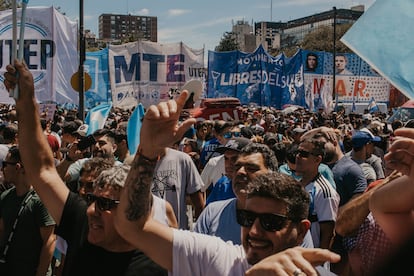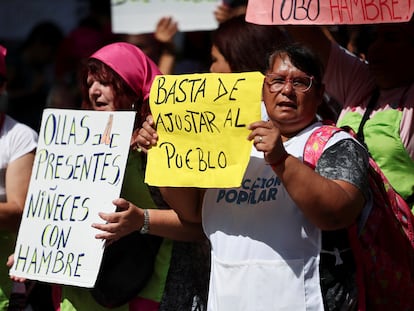General strike in Argentina puts Javier Milei’s government to the test
The GGT, the most powerful labor union in the country, hopes to mobilize at least 40,000 people in Buenos Aires to protest the executive’s plans to scale back the state


Javier Milei is facing his first big challenge on the streets. The general strike called by the General Confederation of Labor (CGT) to protest the Argentine president’s economic policies has swelled into a mass anti-government protest. In addition to the CGT — the largest labor union in the country —, social movements and communities affected by Milei’s sweeping reform plans will march down the streets of Buenos Aires to the doors of Congress on Wednesday. Social organizations expect at least 40,000 people will attend the demonstration in the capital.
After coming to power, the far-right president issued a Decree of Urgency and Necessity to scale back the state. This decree — which must overcome a complex obstacle course in Congress — will fundamentally change a good part of the political, social and economic structure of Argentina. Some of the measures in the law include defunding of Argentina’s film institute (INCAA), privatizing public enterprises and banning the state from intervening to control the prices of food, basic goods, rent and private health insurance.
The move has sparked widespread opposition. The mobilization on Wednesday will be the third mass protest in Buenos Aires since Milei took power a month and a half ago. The first demonstration took place on December 10 — just 10 days after Milei took office — after the president announced his plans to deregulate the economy. The second was held on December 27 as prices skyrocketed due to Milei’s devaluation of the Argentine peso and fiscal adjustment, and social organizations and unions called on the Labor Court to issue an injunction to halt the decree.
In addition to these large-scale demonstrations, there have also been a rising number of spontaneous protests and cacerolazos (a popular protest consisting of people banging pots and pans) from retirees, tenants, environmental activists, cultural workers, as well as unions representing a wide range of workers, from nurses and bank employees to mechanics.
The general strike on Wednesday — the first the CTG has called in five years — encompasses all these demands. In addition to the CGT, which represents truck drivers, health care workers and service station workers, unions that represent state workers, carriers, the press, informal workers, as well as social movements, will also take part in the protest.
Even the opposition has decided to participate in the demonstration. Axel Kicillof, the governor of the province of Buenos Aires and the most visible face of the left-wing Peronist movement, confirmed that he will attend the march, along with mayors of the province, the most populous in Argentina. His decision to join the strike is another sign of his opposition to Milei. While the central government announced that the state workers who join the strike will be deducted a day’s pay, Kicillof said that he will respect workers’ right to strike in his province. All the 20 parties that make up Union for the Homeland (UP) — the Peronist alliance that lost the elections against Milei — will join the strike, but with former president Cristina Kirchner and defeated presidential candidate Sergio Massa out of the scene, Kicillof is likely to be the highest profile politician at the rally.
Milei has criticized Argentina’s unions for creating “two Argentinas.” “There is one that wants to stay in the past and in decline, and another that puts us on the path to being a developed country, which is the one we propose,” the president said on Monday in an interview. On Tuesday, the government’s spokesperson, Manuel Adorni, was even harsher, accusing the CGT of being “on the wrong side of history” and “against working people.”
The tactic of pitting workers and protesters against one another has had a deep impact on the government and its voters. According to a survey by the University of San Andrés, a private institution, the government’s plan to sentence protests who block the streets to prison is one of the measures that has the greatest approval.
The march on Wednesday — which will take place at 3 p.m. local time — will be a challenge for the Milei government, which has established a new protocol, established by Security Minister Patricia Bullrich, that allows security forces to take action if the streets are blocked by protesters. The government has also threatened to make the organizations cover the cost of the police deployment.
But Pablo Moyano, the leader of the trucker drivers union, said Monday that he wasn’t worried about being arrested. “How do you put hundreds of thousands of people in prison?” he asked jokingly. “Do I take 40,000 truck drivers in single file? It’s impossible, it is part of [Bullrich’s] media show, so that no one challenges her.”
Moyano said that the protest would be “peaceful” and expressed hope that it would convince Congress to vote against the bill. “We are workers. We are neither orcs nor paramilitary groups, but we are going to express our discontent for these measures that are being applied,” he said.
Sign up for our weekly newsletter to get more English-language news coverage from EL PAÍS USA Edition
Tu suscripción se está usando en otro dispositivo
¿Quieres añadir otro usuario a tu suscripción?
Si continúas leyendo en este dispositivo, no se podrá leer en el otro.
FlechaTu suscripción se está usando en otro dispositivo y solo puedes acceder a EL PAÍS desde un dispositivo a la vez.
Si quieres compartir tu cuenta, cambia tu suscripción a la modalidad Premium, así podrás añadir otro usuario. Cada uno accederá con su propia cuenta de email, lo que os permitirá personalizar vuestra experiencia en EL PAÍS.
¿Tienes una suscripción de empresa? Accede aquí para contratar más cuentas.
En el caso de no saber quién está usando tu cuenta, te recomendamos cambiar tu contraseña aquí.
Si decides continuar compartiendo tu cuenta, este mensaje se mostrará en tu dispositivo y en el de la otra persona que está usando tu cuenta de forma indefinida, afectando a tu experiencia de lectura. Puedes consultar aquí los términos y condiciones de la suscripción digital.
More information
Archived In
Últimas noticias
Most viewed
- Reinhard Genzel, Nobel laureate in physics: ‘One-minute videos will never give you the truth’
- Oona Chaplin: ‘I told James Cameron that I was living in a treehouse and starting a permaculture project with a friend’
- Pablo Escobar’s hippos: A serious environmental problem, 40 years on
- Why we lost the habit of sleeping in two segments and how that changed our sense of time
- Chevy Chase, the beloved comedian who was a monster off camera: ‘Not everyone hated him, just the people who’ve worked with him’










































